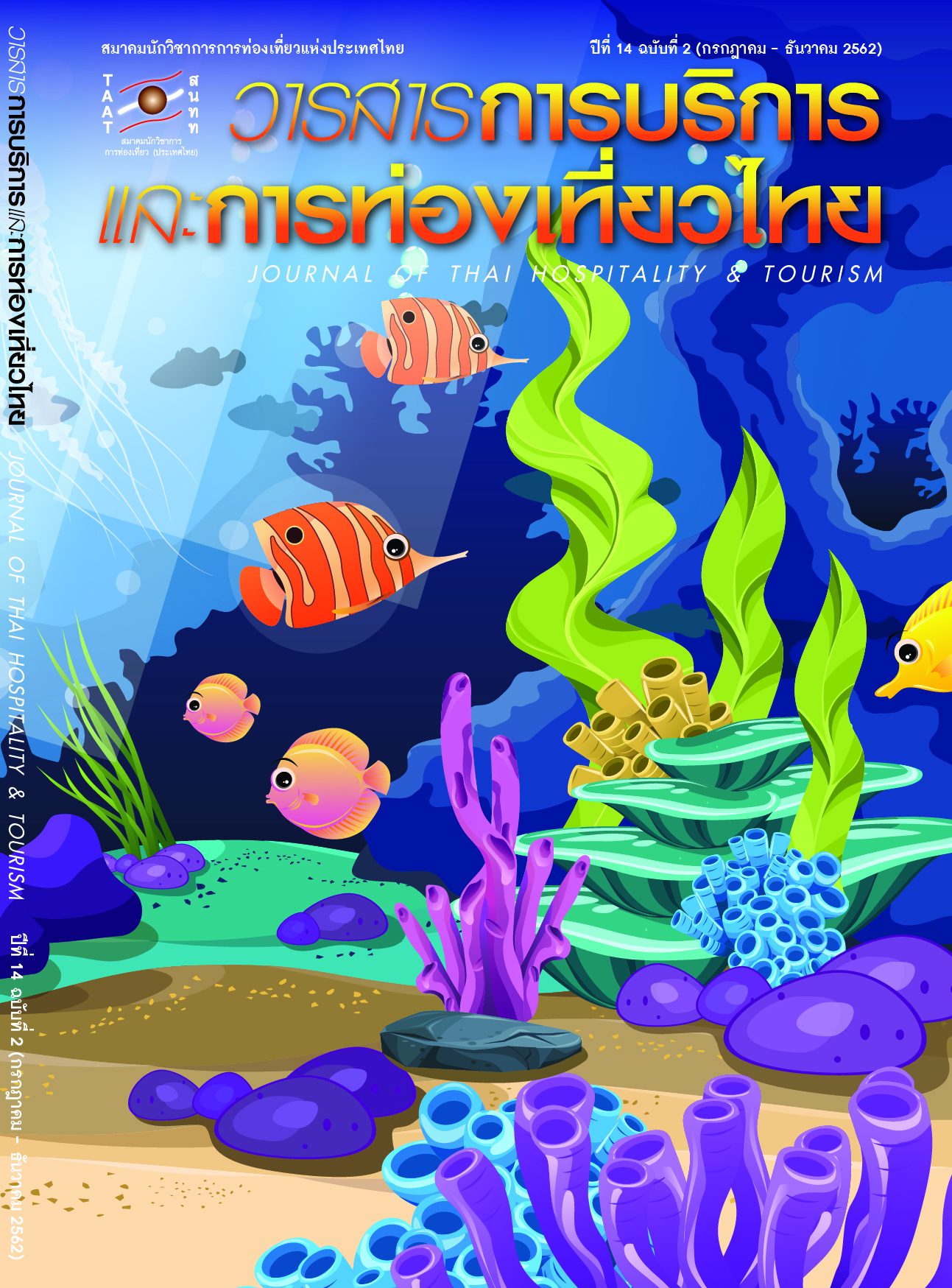แนวทางการให้บริการของสายการบินอัลตร้า โลว์คอสต์ ในประเทศไทย
Main Article Content
บทคัดย่อ
การศึกษาครั้งนี้มีวัตถุประสงค์ 1) เพื่อศึกษาความต้องการการใช้บริการสายการบินอัลตร้า โลว์คอสต์ ของคนไทย 2) เพื่อนำเสนอแนวทางการให้บริการสายการบินอัลตร้า โลว์คอสต์ ในประเทศไทย โดยมีกลุ่มตัวอย่างเพื่อใช้ในการศึกษา ได้แก่ กลุ่มวัยทำงานสัญชาติไทย ที่ไม่ใช่พนักงานสายการบิน มีอายุระหว่าง 15 ถึง 60 ปี และพำนักอยู่ในประเทศไทย จำนวน 400 คน ได้กลุ่มตัวอย่างจากการสุ่มแบบเจาะจง เครื่องมือที่ใช้ในการศึกษาครั้งนี้เป็นแบบสำรวจเพื่อหาแนวทางการให้บริการของสายการบิน อัลตร้า โลว์คอสต์ ในประเทศไทย วิธีการวิเคราะห์ข้อมูล ได้แก่ ค่าร้อยละ ค่าเฉลี่ย และ ค่าเบี่ยงเบนมาตรฐาน ผลการวิจัยพบว่า กลุ่มตัวอย่างกลุ่มใหญ่สุดต้องการซื้อบัตรโดยสารในอัตราที่ถูกที่สุด เมื่อเปรียบเทียบอัตราโดยสายกับสายการบินต่าง ๆ พบว่าอัตราค่าโดยสารของสายการบินอัลตร้า โลว์คอสต์ มีราคาถูกที่สุด สร้างความรู้สึกคุ้มค่าที่เลือกใช้บริการ และยินดีซื้อสินค้า และบริการที่สายการบินนำเสนอเพิ่มเติม ถึงแม้ว่าจะมีราคาสูงกว่าสายการบินอื่น และท้องตลาดก็ตาม รวมทั้งยอมรับข้อกำหนดที่เข้มงวด มีการบริการ และสิ่งอำนวยความสะดวกต่างๆ ที่น้อยกว่าสายการบินอื่น โดยมีข้อแม้ว่าต้องได้รับอัตราค่าโดยสารที่ถูกกว่าสายการบินอื่น ๆ โดยเฉพาะสายการบินโลว์คอสต์ อย่างเห็นได้ชัด การเสนอแนวทางการยึดหลักส่วนประสมทางการตลาด 7 ประเด็น 1) ด้านผลิตภัณฑ์ และการบริการ ผู้ใช้บริการได้ยินดีซื้อสินค้า และบริการ เพิ่มเติม ในราคาที่สูงกว่าท้องตลาด และสายการบินอื่น ๆ หากผู้ให้บริการเสนออัตราค่าโดยสารที่ต่ำกว่าสายการบินอื่น 2) ด้านราคา ผู้ให้บริการต้องส่งมอบอัตราค่าโดยสารที่ต่ำที่สุด และสร้างความรู้สึกคุ้มค่าแก่ผู้ใช้บริการ 3) ด้านการจัดจำหน่าย ผู้ให้บริการสามารถใช้ช่องทางหลัก ได้แก่ ช่องทางอิเลคทรอนิคส์ในการจำหน่าย 4) การส่งเสริมการตลาด ผู้ให้บริการควรเสนอรายการส่งเสริมการตลาดด้านราคา และการส่งเสริมการตลาดผ่านเครือข่ายสังคม 5) ด้านบุคลากร ผู้ให้บริการสามารถใช้พนักงานเท่าที่จำเป็นเพื่อให้บริการกระบวนการต่าง ๆ โดยใช้เทคโนโลยีที่สามารถเข้าถึงได้จากคอมพิวเตอร์ และอุปกรณ์เคลื่อนที่ทดแทนบริการของพนักงาน 6) ด้านการสร้างและนำเสนอลักษณะทางกายภาพ ผู้ให้บริการต้องเน้นความปลอดภัยสูงสุดด้านการบินตามมาตรฐานที่เกี่ยวข้องอย่างเคร่งครัด รักษาเวลาตามตารางบิน นำเสนอภาพลักษณ์ จุดยืน ที่แตกต่างจากสายการบินต้นทุนต่ำอย่างชัดเจน 7) ด้านกระบวนการ ผู้ประกอบการสามารถนำเทคโนโลยีมาใช้ในกระบวนการการบริการหลักเพื่อให้ ทั้งนี้เทคโนโลยีที่ใช้ต้องสามารถให้บริการผ่านคอมพิวเตอร์ หรืออุปกรณ์สื่อสารเคลื่อนที่ และตู้ให้บริการอัตโนมัติได้
Article Details
เอกสารอ้างอิง
[2] Airport of Thailand Public Company Limited. (2014). Annual Report 2014. Retrieved December 26, 2016, from https://aot.listedcompany.com/misc/AR/20150122-AOT-AR2014-TH.pdf.
[3] Airport of Thailand Public Company Limited. (2015). Annual Report 2015. Retrieved December 26, 2016, from https://aot.listedcompany.com/misc/AR/20160112-AOT-AR-2015-TH.pdf.
[4] Ampai, Natta. (2016). Factor Affecting to Use Low Cost or Full-Fares Airlines of Students in National Institute of Development Administration. Term Paper, National Institute of Development Administration.
[5] Deeppa, K., & Ganapathi, R. (2016). A Study on Factors Affecting Customer’s Preference of Low-Cost Carriers. International Journal of Multidisciplinary Research and Development Online, 3(8), 237-244.
[6] Elian, J., & Cook, G. N. (2013). Spirit Airlines: Achieving Competitive Advantage through Ultra-Low Costs. Journal of Aviation/Aerospace Education & Research, 23(1), 23-34.
[7] Faculty of Commerce and Accountancy, Chulalongkorn University. (2015). Different Generation Different Needs: Insight Thai Consumers 2015. Retrieved November 25, 2016, from https://www.manager.co.th/iBizChannel/ViewNews.aspx?NewsID=9580000110621.
[8] Hawkins, D. I., Best, R. J., & Coney, K. A. (1998). Consumer Behavior: Building Marketing Strategy. Boston: McGraw-Hill.
[9] Kardes, F. R., Cronley, M. L., & Cline, T. W. (2011). Consumer Behavior. Ohio: South-Western Cengage Learning.
[10] Kaykrato, Tanasak., & Boonkuson, Sirima. (2015). The Service Factors (Marketing Mix) Affecting Consumer Selection of Low-Cost Airlines at Ubon Ratchathani Provincial Airport. Retrieved December 26, 2016, from https://journal.nmc.ac.th/th/admin/Journal/2558Vol2No1_55.pdf.
[11] Pipatchaisiri, Sivadtra. (2012). Influence Factors for Choosing Low-Cost Airline in Domestic Route of Thai Passengers. KKU Research Journal, 11(2), 154-167.
[12] Thanasupsin, Kittichai., Chaichana, Suraphan, & Pliankarom, Sudtida. (2010). Factors Influencing Mode Selections of Low-Cost Carriers and A Full-Service Airline in Thailand. Transportation Journal, 49(1), 35-45.
[13] Vidovic, A., Štimac, I., & Vince, D. (2013). Development of Business Models of Low-Cost Airlines. International Journal for Traffic and Transport Engineering, 3(1), 69-81.
[14] Yeoh, E., & Kim Lian Chan, J. (2011). Malaysian Low-Cost Airlines: Key Influencing Factors on Customers’ Repeat Purchase Intention. World Applied Sciences Journal, 12(Special Issue), 35-43.


